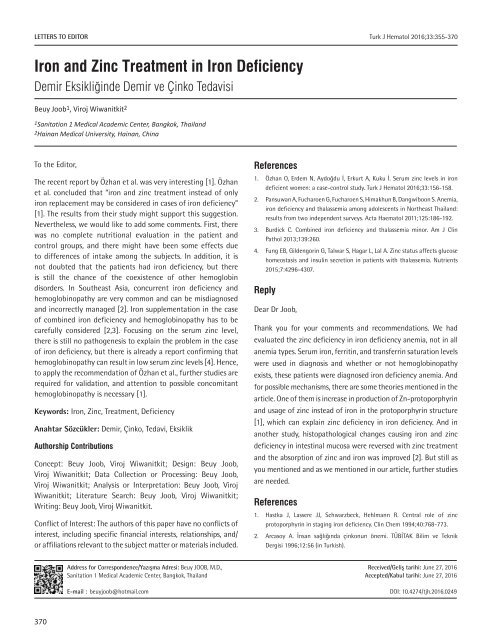Turkish Journal of Hematology Volume: 33 - Issue: 4
Create successful ePaper yourself
Turn your PDF publications into a flip-book with our unique Google optimized e-Paper software.
LETTERS TO EDITOR Turk J Hematol 2016;<strong>33</strong>:355-370<br />
Iron and Zinc Treatment in Iron Deficiency<br />
Demir Eksikliğinde Demir ve Çinko Tedavisi<br />
Beuy Joob 1 , Viroj Wiwanitkit 2<br />
1Sanitation 1 Medical Academic Center, Bangkok, Thailand<br />
2Hainan Medical University, Hainan, China<br />
To the Editor,<br />
The recent report by Özhan et al. was very interesting [1]. Özhan<br />
et al. concluded that “iron and zinc treatment instead <strong>of</strong> only<br />
iron replacement may be considered in cases <strong>of</strong> iron deficiency”<br />
[1]. The results from their study might support this suggestion.<br />
Nevertheless, we would like to add some comments. First, there<br />
was no complete nutritional evaluation in the patient and<br />
control groups, and there might have been some effects due<br />
to differences <strong>of</strong> intake among the subjects. In addition, it is<br />
not doubted that the patients had iron deficiency, but there<br />
is still the chance <strong>of</strong> the coexistence <strong>of</strong> other hemoglobin<br />
disorders. In Southeast Asia, concurrent iron deficiency and<br />
hemoglobinopathy are very common and can be misdiagnosed<br />
and incorrectly managed [2]. Iron supplementation in the case<br />
<strong>of</strong> combined iron deficiency and hemoglobinopathy has to be<br />
carefully considered [2,3]. Focusing on the serum zinc level,<br />
there is still no pathogenesis to explain the problem in the case<br />
<strong>of</strong> iron deficiency, but there is already a report confirming that<br />
hemoglobinopathy can result in low serum zinc levels [4]. Hence,<br />
to apply the recommendation <strong>of</strong> Özhan et al., further studies are<br />
required for validation, and attention to possible concomitant<br />
hemoglobinopathy is necessary [1].<br />
Keywords: Iron, Zinc, Treatment, Deficiency<br />
Anahtar Sözcükler: Demir, Çinko, Tedavi, Eksiklik<br />
Authorship Contributions<br />
Concept: Beuy Joob, Viroj Wiwanitkit; Design: Beuy Joob,<br />
Viroj Wiwanitkit; Data Collection or Processing: Beuy Joob,<br />
Viroj Wiwanitkit; Analysis or Interpretation: Beuy Joob, Viroj<br />
Wiwanitkit; Literature Search: Beuy Joob, Viroj Wiwanitkit;<br />
Writing: Beuy Joob, Viroj Wiwanitkit.<br />
Conflict <strong>of</strong> Interest: The authors <strong>of</strong> this paper have no conflicts <strong>of</strong><br />
interest, including specific financial interests, relationships, and/<br />
or affiliations relevant to the subject matter or materials included.<br />
References<br />
1. Özhan O, Erdem N, Aydoğdu İ, Erkurt A, Kuku İ. Serum zinc levels in iron<br />
deficient women: a case-control study. Turk J Hematol 2016;<strong>33</strong>:156-158.<br />
2. Pansuwan A, Fucharoen G, Fucharoen S, Himakhun B, Dangwiboon S. Anemia,<br />
iron deficiency and thalassemia among adolescents in Northeast Thailand:<br />
results from two independent surveys. Acta Haematol 2011;125:186-192.<br />
3. Burdick C. Combined iron deficiency and thalassemia minor. Am J Clin<br />
Pathol 2013;139:260.<br />
4. Fung EB, Gildengorin G, Talwar S, Hagar L, Lal A. Zinc status affects glucose<br />
homeostasis and insulin secretion in patients with thalassemia. Nutrients<br />
2015;7:4296-4307.<br />
Reply<br />
Dear Dr Joob,<br />
Thank you for your comments and recommendations. We had<br />
evaluated the zinc deficiency in iron deficiency anemia, not in all<br />
anemia types. Serum iron, ferritin, and transferrin saturation levels<br />
were used in diagnosis and whether or not hemoglobinopathy<br />
exists, these patients were diagnosed iron deficiency anemia. And<br />
for possible mechanisms, there are some theories mentioned in the<br />
article. One <strong>of</strong> them is increase in production <strong>of</strong> Zn-protoporphyrin<br />
and usage <strong>of</strong> zinc instead <strong>of</strong> iron in the protoporphyrin structure<br />
[1], which can explain zinc deficiency in iron deficiency. And in<br />
another study, histopathological changes causing iron and zinc<br />
deficiency in intestinal mucosa were reversed with zinc treatment<br />
and the absorption <strong>of</strong> zinc and iron was improved [2]. But still as<br />
you mentioned and as we mentioned in our article, further studies<br />
are needed.<br />
References<br />
1. Hastka J, Lassere JJ, Schwarzbeck, Hehlmann R. Central role <strong>of</strong> zinc<br />
protoporphyrin in staging iron deficiency. Clin Chem 1994;40:768-773.<br />
2. Arcasoy A. İnsan sağlığında çinkonun önemi. TÜBİTAK Bilim ve Teknik<br />
Dergisi 1996;12:56 (in <strong>Turkish</strong>).<br />
Address for Correspondence/Yazışma Adresi: Beuy JOOB, M.D.,<br />
Sanitation 1 Medical Academic Center, Bangkok, Thailand<br />
E-mail : beuyjoob@hotmail.com<br />
Received/Geliş tarihi: June 27, 2016<br />
Accepted/Kabul tarihi: June 27, 2016<br />
DOI: 10.4274/tjh.2016.0249<br />
370

















